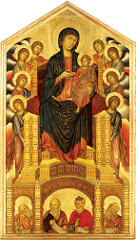
Title: Virgin and Child Enthroned
Time: 1280
(Pre-Renaissance)

Title: Virgin and Child Enthroned
Time: 1300
(Pre-Renaissance)

Title: Scrovengi Chapel
Time: 1300
(Pre-Renaissance)
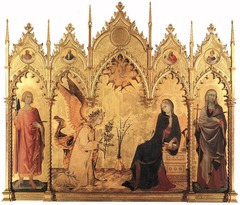
Title: Annunciation
Time: 1330
(Pre-Renaissance)
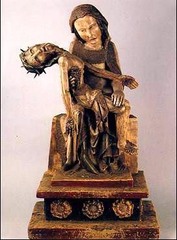
Title: Vesterbild (Pieta)
Time: 1330
(Pre-Renaissance)

Title: The Tribute Money
Time: 1430
(Pre-Renaissance)
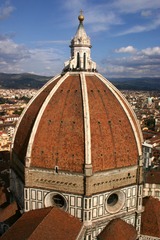
Title: Florence Cathedral dome
Place: Florence, Italy
Time: 1420
(Pre-Renaissance)

Title: Palazzo Medici-riccardi
Place: Florence, Italy
Time: 1420
(Pre-Renaissance)
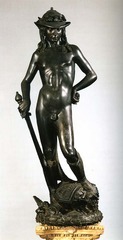
Title: David
Time: 1450
(Pre-Renaissance)
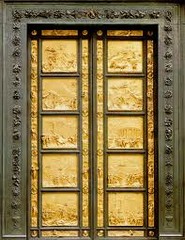
Title: Gates of Paradise
Time: 1450
(Pre-Renaissance)
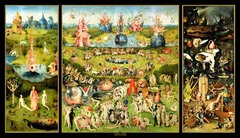
Title: Garden of Earthly Delights
Time: 1500
(Pre-Renaissance)
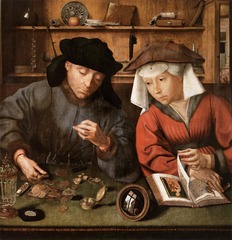
Title: Money Changer and His Wife
Time: 1510
(Pre-Renaissance)

Title: Annunciation, Visitation, Presentation in the Temple, and Flight Into Egypt
Place: Dijon, France
Time: 1300
(Early Renaissance)
Lilies in the background and Mary wearing a blue cloak. Artist uses both architecture and landscape to divide the scenes so that we can have multiple scenes in one panel.
He combines Romanesque and Gothic architecture, perhaps symbolizing the transition from Old Testament to New Testament. God is in the top left corner and on the right hand side, we have the Visitation at the Temple and Flight into Egypt. A pagan statue crumbles as the Christ child approaches.
An example of International Gothic style in his use of vibrant colors and elongated figures.
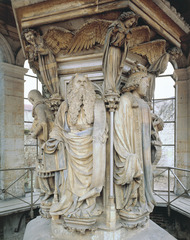
Title: Well of Moses
Place: Dijon, France
Time: 1400
(Early Renaissance)
The base has depictions of Old Testament prophets like Moses and King David. The figures are highly individualized and hold weight. They used to be painted, but the paint has since worn off. There’s a good sense of realism here. The water that pours over them symbolizes the blood of Christ.
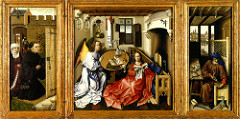
Title: Merode Altarpiece, The Annunciation
Time: 1420
(Early Renaissance)
The lilies on the table symbolize Mary’s purity, the burnt out candle symbolizes the moment of Christ’s conception, Mary holds a prayer book to show her piety, ruffled pages of Old and New Testaments on table signify Gabriel has just arrived, the pot in the background refers to Mary being a vessel for Jesus.
There’s a mousetrap by Joseph that represents God’s trap for Satan, Joseph holds a winemaking device to refer to the Eucharist. Outside of Joseph’s room is a detailed scene of a typical Flemish town. The donor and his wife are on the left panel witnessing this religious scene. Some linear perspective, but not all of the lines match up (multiple vanishing points.) The table, instead of appearing flatter, is shown in full. More accurately, it uses intuitive perspective.
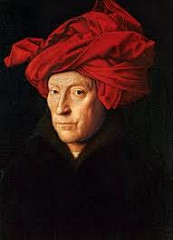
Title: Man in a Red Turban
Time: 1430
(Early Renaissance)
Believed to be a self portrait of Jan Van Eyck due to the man looking directly at the viewer. This was unusual at the time, as most self portraits had the subjects looking away. Eyck is looking at himself in the mirror. Oil painting combines oil with pigment and can be applied thickly or thinly (glazes.) When applying glazes, you can layer them so that the art appears illuminated from within.
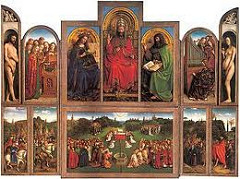
Title: Ghent Altarpiece
Place: St. Bavo Cathedral, Ghent, Belgium
Time: 1430
(Early Renaissance)
Polyptych altarpiece. Has a donor portrait embedded not only to be recognized, but also to be part of a spiritual scene. Two figures at the bottom painted in grisailles.
Annunciation in the middle with prophets at the top. On the back, God wears a triple crown (symbolizes Trinity) with Mary and Joseph on both sides.
At the bottom, angels are gathered to witness the sacrifice of the lamb. The lamb stands on the altar and blood drains into a chalice.

Title: Double Portrait of Giovanni Arnolfini and His Wife
Time: 1430
(Early Renaissance)
It’s debated whether the woman is holding up her skirt to leave with Giovanni or if she’s pregnant. The dog symbolizes fidelity and its Eastern breed symbolizes wealth. Inside the mirror, you can see the back of the woman and man as well as two additional figures.
“Jan Van Eyck was here” is inscribed above it and it’s argued that Van Eyck was a witness to this ceremony and that the other man is a priest. Although it’s a mostly secular piece, the mirror depicts stages of the Cross.
A St. Margaret figure, the patron saint of childbirth, is depicted sitting on top of a cupboard. It’s also argued that it’s a depiction of a wife’s death due to childbirth or that it’s just a portrait of them and their wealth.

Title: Descent from the Cross
Place: Louvain, Belgium
Time: 1430
(Early Renaissance)
Famous for painting grief in a hyper realistic way. Mary swoons as Christ is taken down from the cross. Mary Magdalene’s body is contorted in grief. Joseph of Arathea wears gold and black robes. Nicodemus holds Christ by the ladder. Contrast of light and shadow gives us a sense of the drapery.

Title:Portinari Altarpiece
Place: Sant’egidio, Florence, Italy
Time: 1480
(Early Renaissance)
Donor portrait and commissioned by a Florentine. In the middle is the Nativity scene, on the left is Mary on her way to Bethlehem, and on the right are the shepherds asking for directions to the manger.
Known for combining detail and emotion. Uses atmospheric perspective. To draw attention to Jesus, the bodies are turned toward him and the center where Jesus lays is painted lighter.
The lilies symbolize purity, the columbines sorrow, and the majoricas (vases) in which the flowers sit are decorated with grapevines, which symbolize the Eucharist.
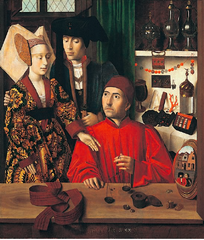
Title: A Goldsmith in His Shop
Time: 1450
(Early Renaissance)
Depicts a genre scene. A goldsmith is shown in his workshop with scales and coins in front of him. Exchange of coins was always done in open view to ensure honesty. Even though it’s a secular portrait, some believe that the scales double as a symbol for the Last Judgement, but current scholars refute this. The cosmopolitan nature of the goldsmith is shown in the different types of coins he has; French, German, Italian, etc.
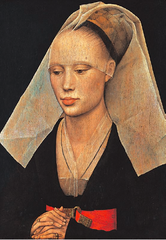
Title: Portrait of a Lady
Time: 1460
(Early Renaissance)
Portraits are used to memorialize a person or moment that had a lot of meaning. Portraits could also be used as a stand-in if they couldn’t be present. In marriages, a portrait would be sent to the other so that they could see their appearance. In this portrait, we can tell that she is wealthy due to her clothing and solemn stance. She looks down and away from the viewer, which is common at the time.
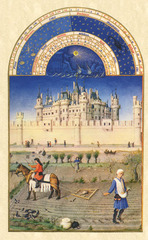
Title: October, from Les Tres Riches Hearts du Duc de Berry
Time: 1410
(Early Renaissance)
Most celebrated book of its time. Has more than 200 pages and many illuminations. Functions as a book of hours.
Since these books were made by hand, they would take a lot longer time to make than a portrait or altarpiece. Done and painted by hand, plus worked on by many artists. The zodiac is featured at the top and at the bottom is a scene of peasants tilling the field. There’s also a scarecrow and washing woman.
International commissioning by Duke of Berry, but worked on by Limbourg brothers. A genre scene. A palace is shown to remind us who the book is for.

Title: January, from Les Tres Riches Hearts du Duc de Berry
Time: 1410
(Early Renaissance)
The Duke of Berry is painted in the group and “Approach, Approach” is inscribed. The tapestry in the back depicts Trojan War and doing this demonstrates his knowledge of history. A dog is given treats, dinner party. Intuitive perspective. It’s not entirely naturalistic, as witnessed by the full view of the table, but objects do get smaller toward the back.

Title: February, from Les Tres Riches Hearts du Duc de Berry
Time: 1410
(Early Renaissance)
A humorous depiction of peasants working on a farm in winter. Inside a shack, peasants lift their garments to warm themselves, but reveal much more than what is considered appropriate by users. They all appear happy to work, showing that the Duke of Berry is a great ruler. This manuscript is religious, but depicts secular scenes.
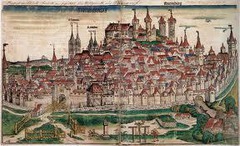
Title: Wilhelm Pleydenwurff and workshop, The City of Nuremberg
Time: 1490
(Early Renaissance)
First published in Latin and 2500 editions of this made. Because of its popularity, it was later published in German. Not all books were painted, but the ones that were had to be done by hand. This meant that painting them would be for the wealthy.

Title: Saint Anthony Tormented by Demons
Time: 1490
(Early Renaissance)
Engraving was a much more flexible medium and became popular. Single pages had become more popular by now.
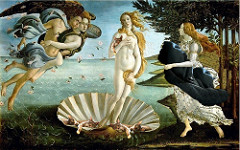
Title: Birth of Venus
Time: 1480
(Early Renaissance)
Unusual, but unique style for Renaissance paintings. An artist based in Florence. This painting is based on the mythological story of Venus’ birth. The first nude woman to reappear since the art of antiquity. She stands on a seashell, half-heartedly trying to cover herself.
No set linear perspective and minimal atmospheric perspective. The waves of the water are stylistic and the figures have a pretty clear outline to them. There’s a focus on patterns and poetic beauty. Considered to be a master of lines.

Title: Primavera
Time: 1480
(Early Renaissance)
Venus is clothed in clothing of Florence. Cupid, Chloris and Flora, the Three Graces, etc. Figures are positioned in field of oranges. We don’t know what it’s supposed to represent, but ideas include marriage and fertility because of Venus and Cupid. The oranges could also be a reference to the Medici family, whose crest had oranges on it.
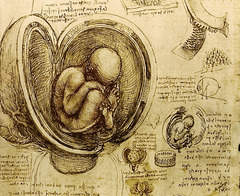
Title: Early in the Womb
Time: 1510
(High Renaissance)
A lot of times, his sketches wouldn’t be entirely accurate, but it was groundbreaking at the time. He invented the cutaway technique and wrote from right to left sometimes. Known as mirror writing.
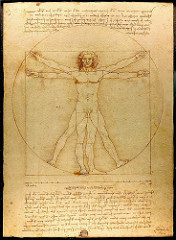
Title: Vitruvian Man
Time: 1490
(High Renaissance)
Vitruvius was an ancient Roman architect that wrote a treatise on architecture. da Vinci equated the ideal man or human form with a circle and a square and compared humans’ proportions to architectural perfection.
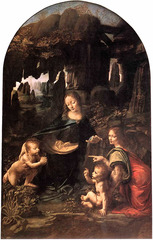
Title: Virgin of the Rocks
Time: 1490
(High Renaissance)
Depicts the flight to Egypt. Baby John the Baptist kneels before Baby Jesus and Mary sits with an angel on the rocks. He uses sfumato, a smoky or hazy effect, and chiaroscuro.
We celebrate his skill in depicting interactions among figures, the Renaissance Triangle (helps to unify the piece), the use of gesture (Mary pulls John in and gestures toward Jesus), the use of light and dark, atmospheric perspective. (landscapes are murky and mysterious) There’s a pool of water that barely shows a reflection. It’s thought to symbolize Jesus’ future baptism by John.
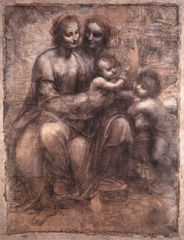
Title: Cartoon for Virgin and Child with St. Anne and Infant St. John
Time: 1500
(High Renaissance)
Mary sits on St. Anne’s lap, her mother, and St. John looks up at baby Jesus. We study this piece for chiaroscuro. Without this modeling, it’s completely flat, but having this piece shows us the effects chiaroscuro has in paintings.
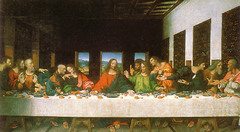
Title: The Last Supper
Place: Santa Maria delle Grazie, Milan, Italy
Time: 1500
(High Renaissance)
Depicts the moment Christ reveals one of them will betray him and we can see the apostles in various states of shock. What’s interesting about this is that there aren’t very many religious symbols. The apostles are grouped in three’s, referencing the Trinity. Figures foil each other. One gestures toward the self as if to ask, “Surely not I?” while another gestures away. The combination of dynamic posts and gestures as well as a unified scene is characteristic of the High Renaissance.
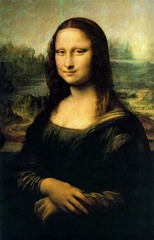
Title: Mona Lisa
Time: 1500
(High Renaissance)
Chiaroscuro is used here in her expression by blurring the lines around her mouth and eyes, making her expression more ambiguous. The wife of a wealthy Florentine silk merchant and one indication of that is this thin veil of silk on top of her hair.
he background is another example of his characteristic murky backgrounds. The fact that it’s showing her full body is innovative.
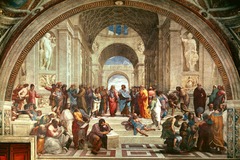
Title: School of Athens
Place: Vatican Palace, Rome, Italy
Time: 1500
(High Renaissance)
Each wall is meant to represent different types of knowledge, philosophy, poetry, etc. Shows us a gathering of ancient philosophers, astronomers, and scientists in a gathering that looks very much like St. Peter’s, which was being rebuilt at the time. We have Plato and Aristotle in the center holding important books that they wrote. Socrates lays on the ground below them, holding a cup of poison he was forced to drink.
Pythagoras is in the left corner and Euclid is in the right corner bending over a telescope with his students. There’s a self-portrait of Raphael in the right corner and a moody Michelangelo wears sculptor’s shoes in the left corner, referring to his desire to be a sculptor rather than a painter. Statues of Apollo and Minerva stand at each corner.
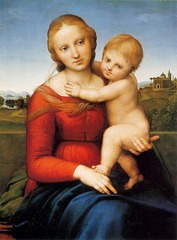
Title: The Small Cowper Madonna
Time: 1500
(High Renaissance)
She’s shown as a monumental form with a pyramidal grouping. The background is very Tuscan and there’s a church in the background that exists in real life. He creates sort of a spiral in the figures. Christ seems to be in motion, as if he’s squirming.
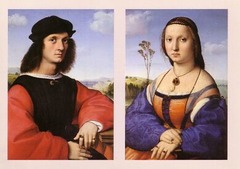
Title: Agnelo Doni and Maddalena Strozzi
Time: 1500
(High Renaissance)
He was a clock merchant marrying into a wealthy banking family. It’s two portraits meant to go together in order to commemorate their wedding. Maddalena was 15, while Doni was 30. Maddalena is being closely modeled on the Mona Lisa and Doni rests an arm on a table, adding more life to the portrait than was previously customary.
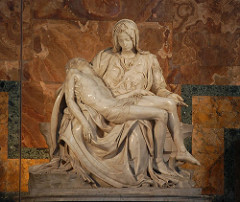
Title: Pieta
Time: 1500
(High Renaissance)
Commissioned by a French cardinal, the Pieta rests inside St. Peter’s Cathedral. It was the expressiveness of Mary that got him other commissions. There’s a silky texture to it and it makes your forget that you’re looking at a statue rather than real figures. Jesus is a lot smaller than Mary, showing his disregard for Renaissance proportions in order to create a beautiful image. Mary is also shown to be pretty young and is being idealized.

Title: David
Place: Galleria dell’Academia, Florence, Italy
Time: 1500
(High Renaissance)
Depiction of classical ideal nude. This is the moment before David faces Goliath when he’s gathering his strength. Usually, he was depicted after his victory. The emotion and intensity of his expressions are amazing. There’s a bit of fear and determination in his eyes. The details are extensive. A look at his hands reveals that Michelangelo even included the veins that real people have.
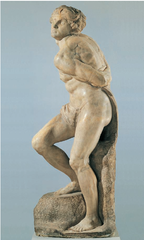
Title: Bound Slave
Place: Louvre, Paris
Time: 1510
(High Renaissance)
Michelangelo worked on a tomb commission that called for 28 statues of slaves in various forms of oppression. A lot of them were unfinished since the pope changed his mind and had him paint the ceiling of the Sistine Chapel.
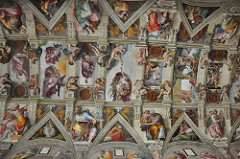
Title: ceiling of the Sistine Chapel
Place: Vatican City, Rome, Italy
Time: 1510
(High Renaissance)
Commissioned by the pope to paint this ceiling. He was reluctant to do it since he thought of himself as a sculptor. Adam and Eve, fall of Man, and Redemption of Man are depicted. Divides the scenes with architectural features and overlaps architecture with nude figures to decorate and unify them. On the outside, are images of Old Testament prophets and sybils. Separation of light and dark, creation of sun and moon, separation of land and water.
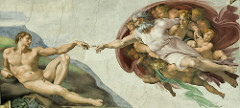
Title: Creation of Adam
Place: Vatican City, Rome, Italy
Time: 1510
(High Renaissance)
Humanistic portrayal of God creating Adam. His fall is foreshadowed by Eve and Christ peeking out from behind God.
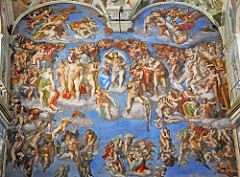
Title: Last Judgement
Place: Vatican City, Rome, Italy
Time: 1530
(High Renaissance)
While the figures were originally nude, an artist later was hired to paint cloth to cover the figures. Those on Jesus’ right are pulled up to heaven and those on his left are pulled down to hell. Jesus is at the center with a halo of light and Mary is shrinking back in fear of what’s happening. Devils pull figures down and angels pull up.
Specific saints surround Jesus and are depicted with attributes of their martyrdom. St. Lawrence was grilled on the stake is shown with a grill. St. Bartholomew, who holds his skin in his left hand, was skinned. Michelangelo has a self portrait of himself on the left side. Overall, he uses grotesque forms here to convey a moral message.
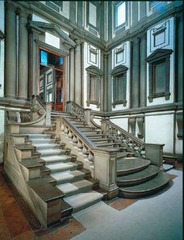
Title: Vestibule of the Laurentian Library
Place: Church of San Lorenzo, Florence, Italy
Time: 1520
(High Renaissance)
Shows his desire to play with standard conventions of architecture. One of the first free-standing staircases in Western architecture.
He messes with proportions by making the staircase really big for the room. The columns recess into the wall and are almost like sculptures themselves, but they do have supportive purposes.
Brackets are usually placed higher to help support, but these are placed lower and are purely decorative. Blind windows have plasters on either side and taper as they go down.
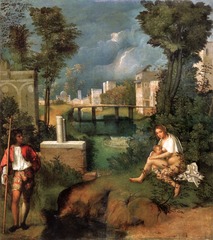
Title: The Tempest
Place: Venice, Italy
Time: 1510
(High Renaissance)
In this painting, there’s a storm in the background. In the foreground, a woman nurses her baby while completely nude and a man stands in the left corner looking at her. It’s more about the mood than the subject matter.
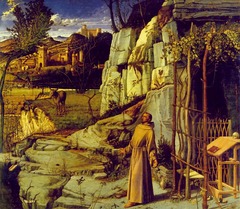
Title: St. Francis in the Desert
Place: Venice, Italy
Time: 1490
(High Renaissance)
Considered to be the father of the Venetian Renaissance. The landscape is broken up more and the subject matter is more religious.

Title: Pastoral Concert
Place: Venice, Italy
Time: 1510
(High Renaissance)
Two male figures play instruments, one of them more wealthy looking. The naked women are allegorical representations of the Muses. One plays the flute, while the other dips her jug into the well of inspiration.

Title: Madonna of the Pesaro Family
Place: Santa Maria dei Frari, Venice, Italy
Time: 1510
(High Renaissance)
Commissioned after Pesaro helped defeat the Turks. St. Peter is presenting Pesaro to the Virgin and the Virgin is presenting Pesaro to Christ. If we compare this composition to the Last Supper or School of Athens, it’s much less structured. Everything comes at us at an angle and off-axis.
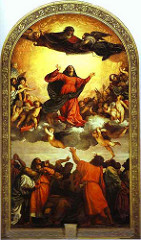
Title: Assumption of the Virgin
Place: Santa Maria dei Frari, Venice, Italy
Time: 1520
(High Renaissance)
He’s trying to create this heavenly light through the light of the windows hitting the painting. While oil paintings usually used monochromatic undercoats, Titian used red-based ones.

Title: Venus of Urbino
Place: Galleria degli Uffizi, Florence, Italy
Time: 1540
(High Renaissance)
Private commission. The nudity is justified in the time by naming the painting after a mythological figure and the depiction of servants fetching her clothes. It’s debated whether or not it’s a marriage portrait, but even with the dog (fidelity) and marriage chest, it’s unclear.
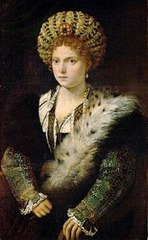
Title: Isabella d’Este
Time: 1530
(High Renaissance)
Influential figure in Venetian politics and a powerful woman. She’s portrayed very wealthily with fur, jewels, and a fancy dress. There’s a focus on the hands and face, as these two features were believed to be the most telling part of the figure. Even though she was fifty at the time, she’s portrayed as being young.
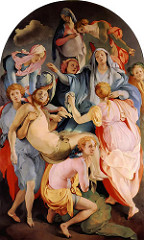
Title: Descent from the Cross
Place: Capponi Chapel, Santa Felicita, Florence, Italy
Time: 1530
(Late Renaissance/Mannerism)
Faces are expressive, ambiguity of landscape, the colors of figures are so vibrant that they seem to glow (artificiality), poses are dynamic and varied, they also overlap. Figures also seem to float, Christ is off-center.

Title: Madonna with the Long Neck
Time: 1540
(Late Renaissance/Mannerism)
Mary is depicted with a long neck and lengthened limbs in order to appear more elegant. Baby Christ is fairly big and takes up a lot of space on Mary’s lap. There’s six angels surrounding them on Mary’s right side. Because of this, the composition appears unbalanced.
The right side of the painting is unfinished; there’s just a column and a small figure meant to depict St. Jerome. The differences in scale between St. Jerome and Mary adds to the sense of ambiguity. Great example of foreshortening.
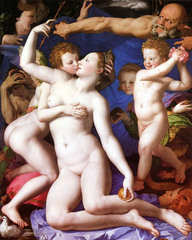
Title: Venus, Cupid, Folly, and Time
Time: 1550
(Late Renaissance/Mannerism)
Commissioned for the Medici. The Medici family loved the Mannerist style for its eroticism. Cupid, Venus’ son, is fondling Venus and kissing her. Venus holds the golden apple and is pulling out an arrow from Cupid’s back. The other figures are more ambiguous. There’s a putti on the right who might represent folly or playfulness.
The old man in the corner has an hourglass behind him and is probably meant to represent Time. One figure tries to hide Cupid and Venus, but Time reveals them. The little girl, whose body is dragon, is Deception and masks are littered at her feet. Envy crouches in the left corner. More focus on limbs and hands.
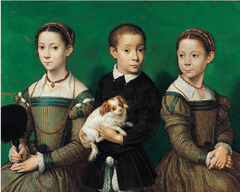
Title: Portrait of the Artist’s Sisters and Brother
Time: 1560
(Late Renaissance/Mannerism)
It’s more informal than traditional portraits and the green background is ambiguous in location. Though their faces are serious, there’s a glint of playfulness in their eyes.

Title: Self-Portrait
Time: 1550
(Late Renaissance/Mannerism)
Miniature portraits were popular because they allowed non-elites to obtain portraits too. The background is again ambiguous and she holds a medallion that seems to include the initials of all of her siblings. We don’t know why exactly she’s holding a medallion, which leads to even more ambiguity.
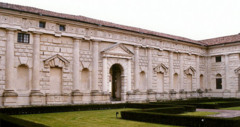
Title: interior courtyard facade of the Palazzo del Te
Place: Mantua, Italy
Time: 1540
(Late Renaissance/Mannerism)
Early stages of Mannerism. The country palace of the Duke of Mantua. Romano was an apprentice to Raphael and helped him paint the Sistine Chapel. It’s meant to be intellectual and witty.
We don’t know if the columns are decorative or functional because of the stone facade. The shapes look carved into, lending it more artificiality. Combination of rounded arches and square ones.
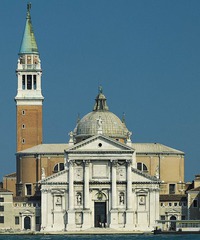
Title: west facade of San Giorgio Maggiore
Place: Venice, Italy
Time: 1500
(Late Renaissance/Mannerism)
Just across the water from St. Mark’s Cathedral. He had studied Vitruvius, Roman ruins, etc. In this work, he combines Mannerism and Classicism to create a solution to crafting a rational/organized facade.
High central nave and lower side aisles. He has a double temple facade. There’s the broader, lower one, but it overlaps with the tall and narrow one.
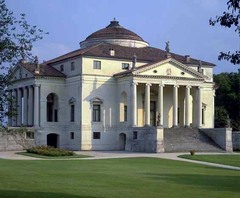
Title: Villa Rotonda
Place: Vicenza, Italy
Time: 1550
(Late Renaissance/Mannerism)
Four identical sides that are modeled off of ancient Roman temples. It’s very rational and geometric. Built for parties and socializing. Palladio was influenced from the Pantheon in Rome, but what’s significant about Palladio’s is that it’s the first dome to be used domestically. Most domed buildings were reserved for churches and public buildings.
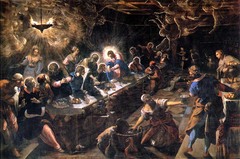
Title: Last Supper
Place: San Giorgio Maggiore, Venice, Italy
Time: 1600
(Late Renaissance/Mannerism)
He divides the earthly and heavenly realm. Dogs climb atop a bucket, while angels dip down from the ceiling. The composition is unbalanced and is left-heavy. It’s also not as clear or order as other paintings. There’s no clear vanishing point. There’s a lot of darkness, but it’s for drama rather than realism.
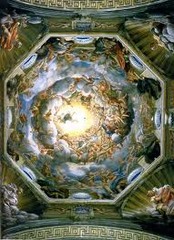
Title: Assumption of the Virgin
Place: donne fresco of Parma Cathedral, Parma, Italy
Time: 1530
(Late Renaissance/Mannerism)
Known for his illusionistic scenes. They give you the sense of three dimensionality. There’s a bunch of limbs flying everywhere (mannerism). We view Christ at an unusual angle and it’s more difficult to find Mary. He’s influenced by Venetian painters in that he uses sfumato.

Title: Isenheim Altarpiece
Place: Germany
Time: 1500
(Protestant Reformation)
This was painted before the Reformation, so art still focused on religious subject matter. It would remain closed for most of the year except on feast days or special gatherings. It was displayed in a hospital that focused on skin diseases.
We seem to have a focus on illness and skin disease in the imagery. It’s very emotional and intense, which is typical of German art at this time. Both John the Evangelist and John the Baptist stand under the cross. St. Sebastian is in the left wing and St. Anthony is in the right. References to amputation are in the bottom panel.
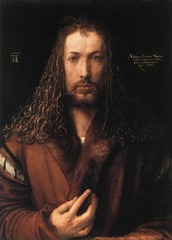
Title: Self-Portrait
Place: Germany
Time: 1500
(Protestant Reformation)
This self portrait is almost like a religious icon; he stares directly at the viewer head-on. His blond hair is changed to brown, the color that was believed to be Christ’s hair color.
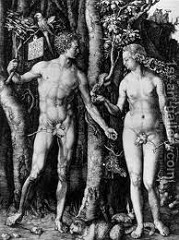
Title: The Fall of Man (Adam and Eve)
Place: Germany
Time: 1500
(Protestant Reformation)
Adam and Eve pose under the Tree while the snake gives Eve an apple. A good example of contrapposto.
The animals in this scene are symbolic. The cat and mouse represents Eve’s corruption of Adam. Cats were a symbol of femininity, especially a femininity of cruel intentions.
The phlegmatic ox is associated with being calm and unemotional, but when out of balance leads to lethargy. The melancholic elk is representative of black bile, when out of balance, leads to cynicism and pessimism.
The sanguine rabbit has to do with sensuality, but when out of balance leads to promiscuity.
These four animals are representative of the Four Humors, which become out of balance with Adam and Eve’s sin. The goat represents lust and damnation. The parrot is symbolic of salvation and is placed by Durer’s signature.
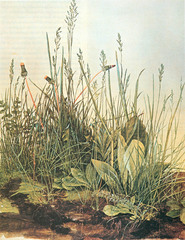
Title: The Great Piece of Turf
Place: Germany
Time: 1500
(Protestant Reformation)
Like Leonardo, Durer also saw nature as a worthy endeavor. In this piece, the viewer is placed on his or her belly to view the foliage.
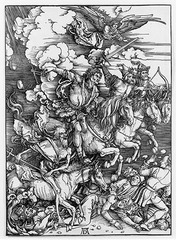
Title: Four Horsemen of the Apocalypse
Place: Germany
Time: 1500
(Protestant Reformation)
He uses middle tones to make the background and whites to depict the forms. We have lots of movement and energy, which is difficult with woodcuts.
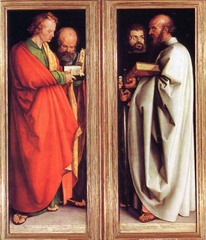
Title: Four Apostles
Place: Germany
Time: 1530
(Protestant Reformation)
A diptych that’s considered to be one of his final works. St. John holds the Bible and St. Peter stands behind him. He’s pushed behind and almost hidden, which is somewhat symbolic of Protestants’ dislike of St. Peter, who is considered to be the first pope. Overall, there is a great focus on the Bible. It’s thought that they also represent the Four Humors, which shows Durer’s interest in medieval medicine.
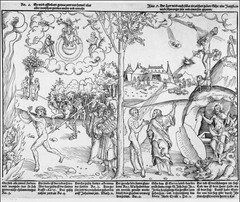
Title: Allegory of Law and Grace
Place: Germany
Time: 1530
(Protestant Reformation)
The left side depicts the Tree of Knowledge of Good and Evil, Moses holding the Ten Commandments, and Death chasing a man to Hell. Judgement.
On the right side, Christ has just resurrected and a beam of light emanating from Christ’s crucified body shines on the man’s body, redeeming him. A Protestant statement saying that people are saved on faith alone and not on good deeds.
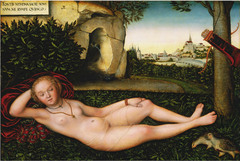
Title: Nymph of the Spring
Time: 1530
(Protestant Reformation)
Clear associations with Venus. (two doves and Cupid’s quiver sitting by the trees.) She’s half asleep. She’s not an example of an idealized female form. She’s more of a sharp outline and has a very awkwardly shaped head.

Title: Francis I
Place: France
Time: 1530
(Protestant Reformation)
Francis I was a humanist whose goal was to modernize France. It’s not very naturalistic, but the puffiness of his sleeves and the broadness of his shoulders helps convey the king’s sense of power.
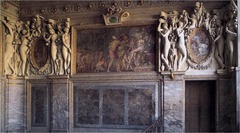
Title: Stucco and Wall Painting
Place: Chamber of the Duchess of Etampes, Chateau of Fontainebleau, France
Time: 1540
(Protestant Reformation)
Influenced by Italian architecture, which was unusual since most French architecture was styled in the French Gothic mode. The slim forms of the nymphs are a lot like the forms of Mannerism, so Mannerism might have influences here.

Title: West Wing of the Cour Carree
Place: Palais du Louvre, Paris, France
Time: 1550
(Protestant Reformation)
Done in French Classicism, which while similar to French Gothic, is more influenced by Italian Classicism, especially in the lower levels where Italian loggia (open area on one side, arched openings on the other) lie.
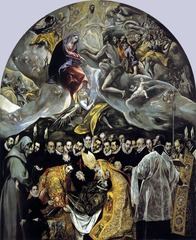
Title: The Burial of Count Orgac
Place: Spain
Time: 1590
(Protestant Reformation)
It’s like Mannerism in that it focus on expressions rather than realism. Uses style to divide heavenly realm from earthly realm. The lower half of the painting is Venetian realism.
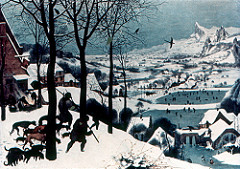
Title: Return of the Hunter
Time: 1570
(Protestant Reformation)





